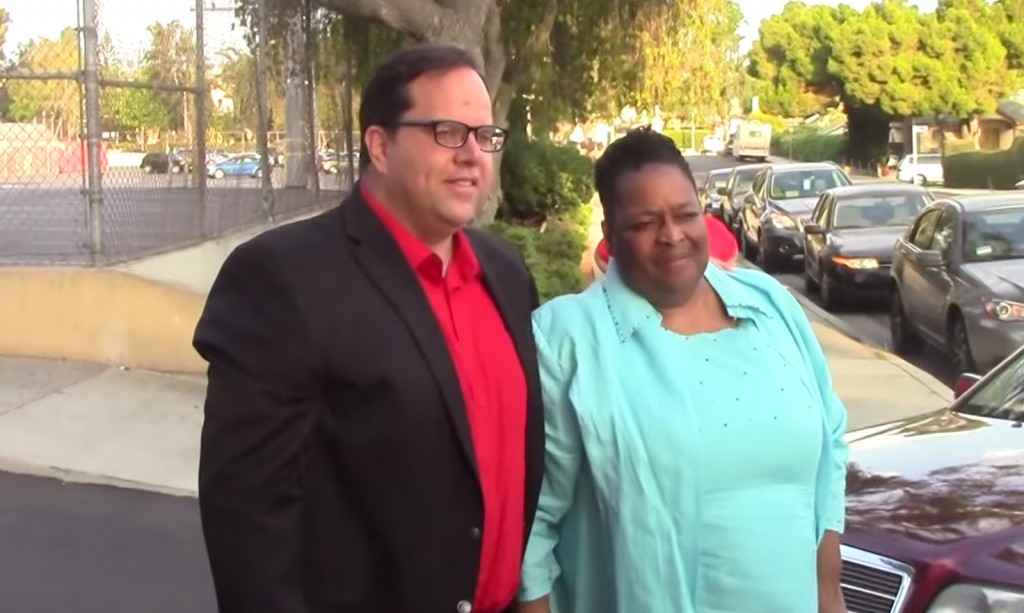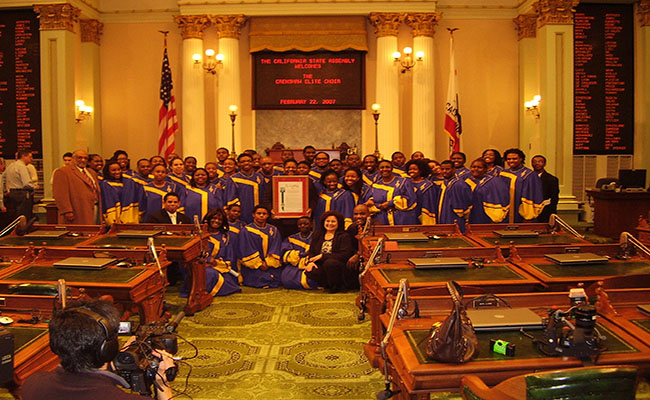
Iris Stevenson arrives at Crenshaw High after being released from “teacher jail.” Scroll below for video of Stevenson’s return. | Amanda Scurlock
At Crenshaw High School in South Los Angeles, the 2014-2015 school year almost began without one of the campus’s most beloved teachers. The Los Angeles Unified School District announced in August that music instructor Iris Stevenson had been restored to her post. However, questions about her several-month-long absence remain. The case has shed light on “teacher jail,” the unofficial nickname for a sort of institutional purgatory for district teachers, which until recently meted out a virtually secret form of punishment.
The LAUSD removed Stevenson from her classroom in December 2013, shortly after she returned from a performing trip with the Crenshaw Elite Choir to Washington, D.C. and Paris. Of the 20 participants, only three were enrolled Crenshaw students. The rest of the group consisted of alumni, chaperones and musicians from around Los Angeles. Upon their return, district authorities reassigned Stevenson, and did not explain why to students and families. She had worked at Crenshaw since 1985.
“Her case, which is a confidential, personnel matter, remains under investigation,” the district said in a statement last month.
Alumni, faculty and community figures decried Stevenson’s ouster, overwhelming the principal’s office and the district with phone calls to vouch for her good character and to demand justice. As a former student of Stevenson’s, I supported their efforts.
“We have to let the school and the district know that we love Ms. Stevenson and what [LAUSD is] doing is not right,” said Vanity Brown, a Crenshaw alumna who spearheaded the protests against LAUSD’s action this spring.
Brown created a Facebook group called “Team Iris Stevenson” to spread information about the case to others who opposed Stevenson’s suspension. Brown also made suggestions of what to say when speaking with LAUSD officials or the Crenshaw principal. With the Facebook group, Brown mobilized generations of Crenshaw alumni who wanted to share memories of Stevenson.
“She opened a lot of doors for me when it came to going places,” said Brittney Hall, a recent graduate from Crenshaw.
Many students, parents and alums believe Stevenson was penalized for taking students on the trip without submitting the proper paperwork. Her students and advocates can’t understand why such a minor infraction would call for such a serious punishment.
“She did not do anything wrong,” said Shelieha White, a senior at Crenshaw High and one of the three students who participated in the trip. White said she thought bigger motives may have been at play, explaining her hunch that LAUSD is “trying to close down our school.”
“They don’t like Crenshaw,” she said.
Supporters of Stevenson and other suspended teachers believe LAUSD Superintendent John Deasy supports a new pedagogical approach that focuses more on standardized tests than on enforcing critical thinking and creativity – and that this emphasis might explain the crackdown on Stevenson.
“All teachers must administer these tests, and then they are judged on the performance of each student, and if their students don’t perform as required, the students are labeled failing and the teachers are labeled failing,” said JoAnn Wypijewski, who wrote “Where Shame is Policy: Inside LA’s ‘Teacher Jail” that appeared in the May 19 issue of The Nation.
“Teachers are under fire tremendously,” she added. “What is exciting, though, are the teachers who are fighting back.”

Amanda Scurlock and her sister Leah pose with Iris Stevenson in front of the Eiffel Tower during the Crenshaw Choir’s trip to France in December 2013. | Amanda Scurlock
Converting Crenshaw to a charter?
Many who followed Stevenson’s case said LAUSD officials see teachers like her as unwanted obstacles to the ongoing effort to transform Crenshaw into a charter school.
“The Superintendent and the LAUSD desire to reconstitute Crenshaw High School, which they’ve already kind of done,” said Brown, the outspoken Crenshaw alum who runs the Facebook support page for Stevenson.
Of the 62 teachers at Crenshaw, 33 were laid off with less experienced teachers taking their places, said Alex Caputo-Pearl, president of the United Teachers of Los Angeles and a former Crenshaw teacher. These changes happened after the 2012-2013 school year when the LAUSD board members voted to reconstitute the school.
For years, charter school organizations like Green Dot and Inner City Education Fund have been trying to take over Crenshaw High School, according to Caputo-Pearl. Teachers and parents fought it, but the charter organizations responded by building charter schools around Crenshaw.
“Those charter schools drained out a lot of the enrollment, particularly the higher performing students,” he said. “Those are the students targeted by charter schools.”
See also from the LA Times: Ousted Crenshaw teachers claim anti-union bias
Hoku Jeffrey, a national organizer for the Coalition to Defend Affirmative Action, Integration and Immigrant Rights and Fight for Equality By Any Means Necessary, or BAMN, said that the majority of teachers transferred out of Crenshaw had taught there for more than 10 years. Jeffrey said he believes the more established teachers present a challenge to the Superintendent’s plan to transform the school.
“Its much harder for [the district] to privatize the public school if there are those types of ties still in the community,” he said.
According to Caroline Wong, a national organizer at BAMN, Deasy may have learned about charter schools through The Broad Superintendents Academy, an 18-month program run by philanthropist Eli Broad that trains administrators in strategies to improve urban school districts.
“They train ex-military people, businessmen and administrators on how to systematically “charterize” the school district they will be assigned to,” said Wong.
Since 2012, The Broad Foundation has honored high-performing charter organizations with the Broad Prize for Public Charter Schools and $250,000 annually. The Foundation also awards $1 million to the highest performing and improved school district each year.
Stevenson was involved the fight against the reconstitution of Crenshaw, an action that LAUSD board members agreed on in 2013, according to supporters. This fact makes Stevenson’s trip to “teacher jail” look like an act of retribution for opposing their plans. LAUSD officials declined to comment on the district’s relationship with charter school organizations.

Alex Caputo-Pearl greeted Iris Stevenson at Crenshaw when she was allowed back on campus. | Amanda Scurlock
A look inside teacher jail
The web site teacherjail.com, a resource page for “rehoused teachers,” says that when the teachers get reassigned, they are told to report to an Educational Service Center, sometimes without a specific explanation about the district’s charges against them. Articles from L.A. School Report and L.A. Weekly have revealed the surprisingly large number of teacher suspensions to an unaware public, describing the tedium of the punishment for teachers.
“They were sitting at cubicles, some of them would talk to each other but some of them would read,” said Hillel Aron, who wrote “LAUSD Rubber Rooms Crowd Up” for the L.A. Weekly. Aron was able to spend time at the Educational Service Center, and noticed a pattern in the demographic of the detainees.

Teacher jail is also known as “rubber rooms,” according to an LA Weekly article.
“There were a few younger [teachers], but it was mostly older teachers,” Aron said. “A lot of them were trying to tell me that this was being done specifically to target and wash out older teachers.”
Wypijewski wrote in The Nation that various facilities have been used to house teachers throughout Los Angeles, including auditoriums and classrooms. Some teachers get assigned to LAUSD headquarters in downtown Los Angeles where they endure being completely ignored by fellow employees.
“If a teacher is placed in LAUSD headquarters, they are surrounded by not only other accused teachers but by employees of the LAUSD who have been instructed not to look them straight in the eye, not to talk to them, not to engage with them,” she reported.
After 10 years of teaching English and two years of being a dean at Crenshaw High, Michael Griffin was also reassigned along with Stevenson. The district put him in an “Intensive Support Unit” in district headquarters, on a regular office floor where district employees would conduct business. A colleague whom he frequently talked to while he was a dean at Crenshaw would completely ignore him.
“It was almost like they have been told not to speak to us,” he said.
Griffin spent more than a year in “teacher jail” due to what he says was a false claim:
“The principal received a phone call from a person who said that they were 27-years-old and that 11 years prior, they said, they had a relationship with me,” he said. The principal took action, alerting the school police.
In his unit, the teachers were separated into two groups. One of those groups, Early Education, had stricter rules than the other group.
“In Early Education, you could not bring electronics with you, but on the other side you could,” said Griffin. “On the side that I was on, you could bring electronics and you could bring books to read, you could even read the Bible, but in Early Ed, they couldn’t read the Bible.”
Griffin’s unit consisted of four cubicles and housed 30 to 40 people. They sat elbow to elbow, facing toward the partitions with their backs to the center of the room. The teachers had to remain in that area unless they had to use the restroom, go on break or eat lunch. According to Griffin, teachers could be cleared of the allegations that sent them to “teacher jail,” but then might find themselves relieved of their duties because of rules they broke while in “teacher jail.”
“You weren’t allowed to have your cell phone out during working hours — I saw a couple of people get in trouble for that,” said Griffin. “You can’t make phone calls during that time period.”
Griffin said most of the teachers in his unit were people of color, mostly African American men, mostly over 50 — in other words, teachers with more seniority who were therefore drawing higher pay.
“In relation to the number of African American males that actually worked for the district, it was imbalanced,” he said.
LAUSD declined to comment on the specific demographics at these facilities.
The fight to bring Stevenson back
During the absence of these experienced Crenshaw teachers, representatives from BAMN began mobilizing Crenshaw students. Wong and Jeffrey met with a core group of 10 students several times a week after school. This small group of students mobilized their peers, demanding that LAUSD allow Stevenson to return to the classroom. Among that core group were students who say they felt the weight of her absence, despite the fact they had never taken any of her classes.
“When I first came to the school, Ms. Stevenson was the first person I met,” said Airreyuna Guilliard, an eleventh grade student who enrolled at Crenshaw in the last school year. Stevenson offered help and support to her. This act of kindness is rare at Crenshaw high school, according to Guilliard. Although she did not have any classes with Stevenson, she would visit her twice a week.
Johnqueenia Wagner, a tenth grade student, was never enrolled in Stevenson’s classes but would visit her during nutrition and lunch.
“Ms. Stevenson was not like any regular teacher, she was a teacher you could come and talk to,” said Wagner. “She was a teacher [who] understood and cared.”
BAMN activists distributed petitions to students and encouraged them to wear fuchsia ribbons to show solidarity with Stevenson and to express hope that LAUSD would let her return to Crenshaw.
“It’s been important to unite the students and the community,” said Jeffrey, the organizer from BAMN, back when he was fighting to get the district’s attention. “We are doing the petitioning to unite students to take action, to picket, to demonstrate, to march until Dr. Stevenson has returned.”
Stevenson’s supporters attended LAUSD board meetings but were sometimes impeded by changes in the date or time of meetings. Carolyn Owens-Horton, a longtime supporter of Stevenson, recalled one time when Jeffrey called LAUSD to get permission for students to protest at a particular board meeting. She said LAUSD changed the time of the meeting without informing BAMN or the Crenshaw students.
“Los Angeles Unified was supposed to have a meeting at 1:30 p.m.,” said Owens-Horton. The afternoon meeting time accommodated Crenshaw students because the school was on a shortened day schedule.
“Then they went and changed the time to 9:30 in the morning and they ended early.”
The LAUSD announced that it had discontinued “teacher jail” in May. The suspended teachers since then have been required to call the district to register their time from home, said Griffin. Although the district abolished the practice of housing teachers in units, a suspended teacher still must await a district investigation. Caputo-Pearl said he believes the LAUSD is not abiding by its own rules by dragging out these investigations.
The Office of the Superintendent released a bulletin regarding the reassignment of teachers back in August of 2012, stating that, “Every attempt will be made to complete all full investigations within 120 working days from the date the case is opened.” Although Stevenson was allowed to return to the classroom this fall, her investigation has not yet run its course. Other housed teachers still have not been permitted return to their schools, Caputo-Pearl said.
Since the cancellation of “teacher jail” this past spring, he said, “teacher jail” has not ended. It’s simply been relocated.
“The educators are not back to their schools, in the classroom with their students, with their program,” said Caputo-Pearl. “They are just reporting to a different place, which is home.”
During Stevenson’s absence, I felt sad that students would miss out on the opportunities that I had being one of her students, like visiting France in December and Korea during the summer and singing with the likes of Smokey Robinson and Enrique Iglesias. Most of all, I feared, they would miss the life lessons she imparted during rehearsals. She did this to give context to the songs we sung, to remind us to annunciate our words, and to help us be better performers and people.
Amanda Scurlock graduated from Crenshaw High School in 2008 and sang with Iris Stevenson in the choir from 2004 to 2008.
______________________________________________________________________________________
The return to Crenshaw
Watch Iris Stevenson take her first steps at Crenshaw after months in teacher jail:
Like Intersections on Facebook, follow us on Twitter and sign up for the Newsletter to stay in the loop on news and views from South L.A.
















If children have a constitutional guarantee of high-quality teachers, why does the LAUSD allow institutionalized bullying to keep great teachers from the classroom? http://www.changethelausd.com/accountability.html